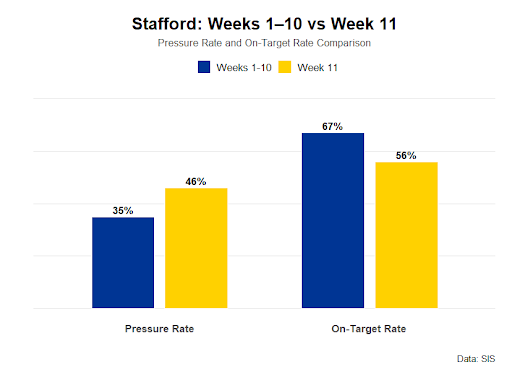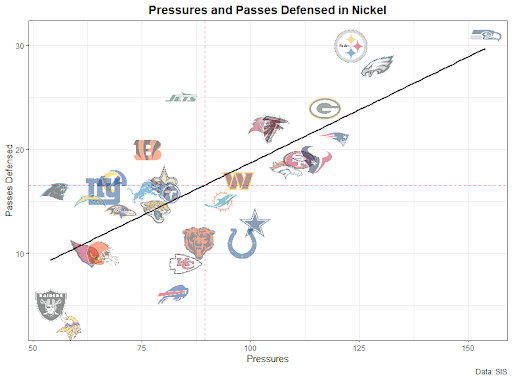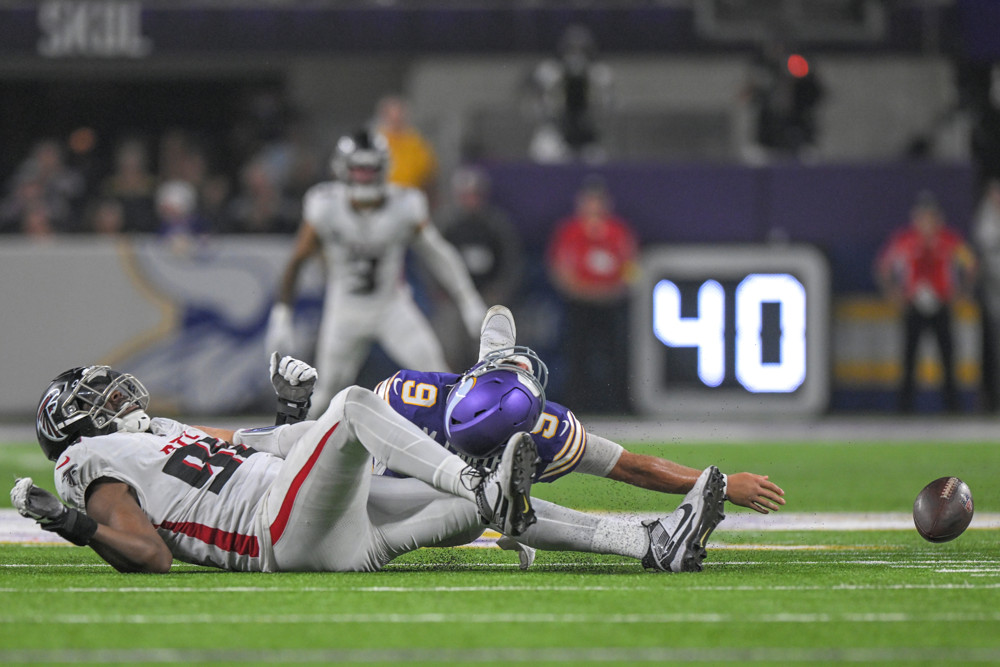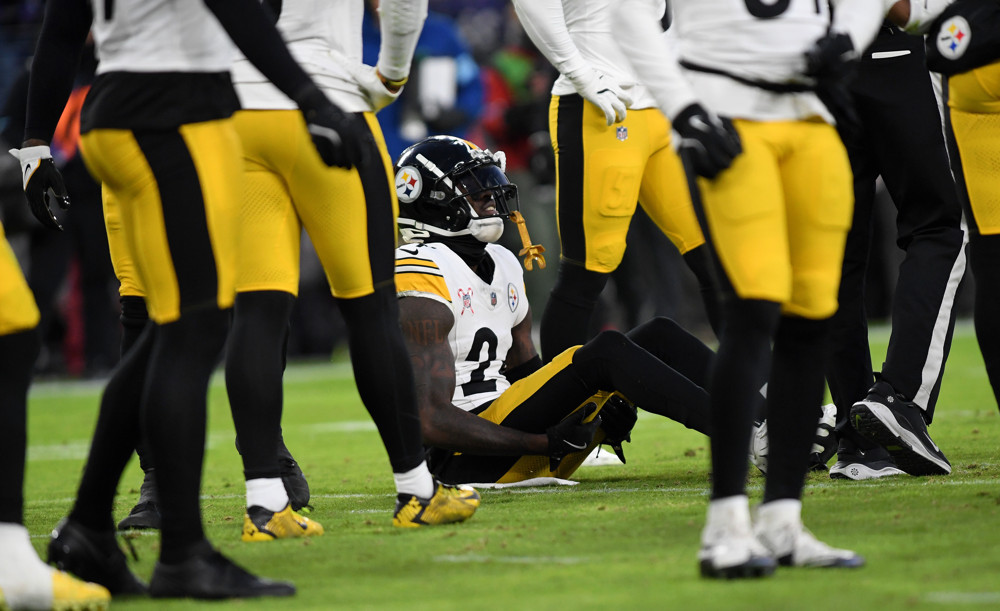The Seattle Seahawks did not get what they were looking for when they visited Los Angeles, leaving town with a loss to an excellent Rams team and taking a significant blow to their odds of capturing the NFC West crown. Much has been made about Sam Darnold’s poor performance in big time games – rightfully so – and that will continue to be the case until he can flip the script.
All is not lost in the Emerald City, however. Despite all four interceptions ending up giving the ball back to the Rams in Seattle territory, the Seahawks managed to somehow still have a chance to win it with a kick as time expired, mostly thanks to their defensive unit.
Let’s take a deeper look into what makes them one of the best defenses in the league and why they still have a shot to make some noise come January.
The Rams came into the matchup ranked as the 2nd-best offense in our Total Points Per Play metric and had been on a heater, dropping 34 points or more in each of their previous three games. The Matthew Stafford MVP campaign was in full swing, with him tossing 13 touchdowns against no interceptions in that span.
Stafford had a much less enjoyable time this past Sunday, mustering just 130 yards on 28 pass attempts.
Stafford was pressured on 46% of those dropbacks, more than 10 percentage points above his season average. His on-target rate was also down more than 10 percentage points below his season average when pressured, and his average throw depth was four yards shallower than usual.

In a press conference a few days before the game, Seahawks head coach Mike Macdonald said he “agreed to a large extent” when asked about Greg Olsen’s comments on how he would deploy defensive units based on down and distance tendencies rather than match up based on personnel.
The Rams deploy 13 personnel (1 running back and 3 tight ends) more than any other team in the league, which is something that could be awkward for a defense to handle if it were inclined to sub players to match. From weeks 1 to 10, the Rams had both quantity and quality when passing out of 13 personnel, posting a top five success rate.
So one could think that the deployment based on down and distance approach is better suited to stopping this sort of attack, but it is not so simple. The Rams also posted a top five rushing success rate out of 13 personnel before Week 11. They want to dictate the terms of the matchup.
If the opponent tries to meet size with size, they will get those bigger bodies out in space and pressure them to cover. If the defense goes lighter with nickel or dime to defend the pass, they will force those defensive backs to make tackles and defend the run.
The Seahawks do have the personnel to win with this aforementioned approach. They play in nickel more than any team in the league, including against 13 personnel. They rank 1st in passes defensed, sacks, and pressures. And in this game, the Rams were able to gain only 4 yards on 6 pass attempts in 13 personnel against the Seahawks (they did score a passing touchdown).

Perhaps more impressively, against the run, Seattle ranks 2nd in EPA per carry allowed and 7th in run stuff rate (rushes resulting in 0 or fewer yards). Kyren Williams did break a 30-yard run, but outside of that, he and Blake Corum were held to 15 yards on 10 carries while in 13 personnel. With Uchenna Nwosu, DeMarcus Lawrence, Leonard Williams, and Byron Murphy II, Seattle has a four-man front capable of stopping the run even when in nickel.
A player to keep an eye on is Nick Emmanwori, the South Carolina safety the Seahawks traded up for to take at near the top of the second round in last year’s draft. Emmanwori came into the league with a bit of that athletic but raw stereotype, but he has shown he can still be an all-around playmaker as he continues to develop his game.
In seven games, he has already recorded seven passes defensed and five tackles for loss against the run, showcasing the type of versatility necessary to make Macdonald’s scheme soar. They are stylistically different, but one can see what type of impact they envision him to be capable of when you think back about Macdonald’s deployment of a certain All-Pro safety he coached in Baltimore, Kyle Hamilton.
In order for the Seahawks to truly be taken seriously and considered among the league’s elite, they must prove that they can dictate the terms on offense.
Seattle has enjoyed offensive success up to this point in large part due to its ability to complete explosive plays against base defenses. The Seahawks rank 1st in passing EPA and boom rate when facing base. However, last week’s game showed that teams will not make it so easy for them going forward.
The Rams invited the Seahawks to try to run on them, primarily playing in dime and nickel. Though not a poor showing overall, Seattle could not truly take advantage when the Rams brought in lighter bodies, gaining only 20 yards on six carries against their dime defense.
On the season, Seattle ranks in the bottom 10 in rushing EPA per attempt against both dime and nickel. Teams will continue to encourage the Seahawks to run the ball until they can prove they can punish defenses on the ground.
Until that happens, Seattle will continue to have to be overly reliant on its passing game to make up ground, which in this matchup turned out to be its death knell. The Seahawks had the most pass attempts versus dime personnel in Week 11. They have a negative passing EPA for the season when facing dime. Darnold needs to demonstrate he can perform consistently when in obvious passing down situations.
The Rams visit Seattle for another clash in Week 16. The Seahawks defense will be ready. The question is will the offense be? The answer to that will determine whether or not the result will be different for their rematch that could decide the NFC West crown.



